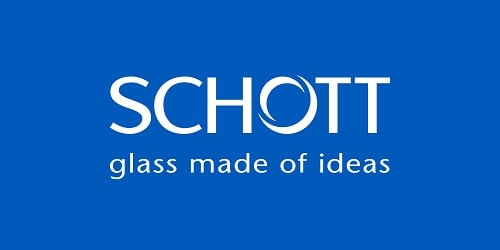
Illuminated SCHOTT PURAVIS® fiber bundle
Why is the light spectrum of SCHOTT‘s lead-free PURAVIS® glass fiber a critical topic and what distinguishes it from e.g., a fused silica fiber? This is a question that continuously comes up in discussions with the designers and engineers of medtech devices.
Unlike a fused silica fiber, our optical fibers use multicomponent glasses. This means that we have to reconcile different properties in the glass components:
- The glass must be suitable for fiber drawing.
- The glass must be reprocessable and chemically resistant.
- The glass must provide sufficient transmission and transport enough light from the light source to the distal end of the scope.
- The glass must deliver a stable light spectrum.
At the same time, these multicomponent fibers cover a different spectrum of transmittable wavelengths compared to fused silica fibers.
Applications at the edge of the visible wavelength spectrum
In medical technology, we are familiar with classic white-light endoscopy, which operates in the visible wavelength range between about 400 and 780 nm. In addition, there are interesting applications at the “left and right edges” of this spectrum, which our PURAVIS® fibers help enable.
Photodynamic diagnostics
At the left edge of the visible wavelength spectrum, at 405 nm, Photodynamic Diagnostics (PDD) is made possible. This involves the use of tumor markers which, when viewed with blue light, make malignant tumor cells visible so that they can be removed with maximum precision. This aspect is particularly important in brain surgery, for example, in order to remove cancerous tissue without damaging healthy tissue.
Fluorescence diagnostics
In the near-infrared range to the right of the visible wavelength spectrum, i.e., at around 800 nm, special markers also play an important role. For example, the green ICG marker becomes active between 780 and 810 nm, which is used in fluorescence diagnostics. Here, too, the focus is on high-contrast imaging to clearly show tissue structures.
The effects of solarization on PURAVIS® fibers
How do solarization effects come into play in this wavelength spectrum? Solarization, the discoloration of glass, is known to reduce transmission.
With our lead-free PURAVIS® fibers, we find that the effect of solarization occurs almost immediately when the light source is switched on. This means that the drop in transmission is experienced directly, but it remains stable and thus calculable for the duration of the application. In other words, the transmission remains constant for the duration of the surgery and shows no further degradation over time.
In contrast, with lead fibers, the user experiences continuous degradation in transmission. At the end of the solarization process, the transmission loss of both fibers is almost identical in terms of amount. It is important to me that a user is aware of this difference.









